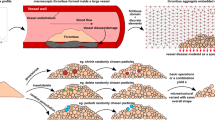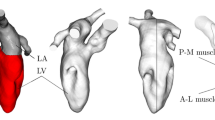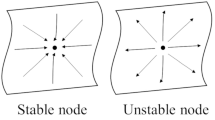Abstract
Thrombus formation is one of the major complications in myocardial infarction. One of the causes is known to be the regional hemostasis, i.e. the presence of zones where the intraventricular flow is characterised by low stretching of the fluid elements and low mixing. Though Finite Time Lyapunov Exponents (FTLE) have been used both in vivo and in vitro to identify the overall features of cardiovascular flows by means of the Lagrangian Coherent Structures (LCS), they have been introduced in fluid dynamics as descriptors of mixing. Therefore, we investigate the alteration of the intraventricular mixing in an infarcted left ventricle by means of FTLE, looking for the signature of regional hemostasis. The study is carried out on 3D numerical simulations: a ventricle dyskinetic and dilated because of an ischemic pathology is compared to a healthy one and to another with a deviated inlet velocity profile, simulating the presence of a Mechanical Prosthetic Valve in anatomical position. The LCS analysis highlighted the key vortical structures of the flow and their evolution, revealing how they are affected by changes of the ventricle geometry and mobility. Afterwards, the FTLE statistics showed a similar behaviour in the healthy and deviated inlet cases, where hemostasis was not observed, although flow patterns were very different to each other. Conversely, the infarcted ventricle exhibited significantly different values of FTLE statistics, indicating a much lower mixing that is related to the presence of a stagnating region close to the apex. Such differences suggest that FTLE can be considered a potentially useful tool for the characterisation of the mixing properties of the intraventricular flow and, in particular, for the identification of regional hemostasis. Therefore, further investigations are needed to test the sensitivity and specificity of FTLE statistics to the severity of the pathology.











Similar content being viewed by others
References
Kheradvar A, Pedrizzetti G (2012) Vortex formation in the cardiovascular system. Springer, London
Kilner PJ, Yang GZ, Wilkes AJ et al (2000) Asymmetric redirection of flow through the heart. Nature 404:759–761. doi:10.1038/35008075
Pedrizzetti G, Domenichini F (2005) Nature optimizes the swirling flow in the human left ventricle. Phys Rev Lett 95:108101
Pierrakos O, Vlachos PP (2006) The effect of vortex formation on left ventricular filling and mitral valve efficiency. J Biomech Eng 128:527–539. doi:10.1115/1.2205863
Gharib M, Rambod E, Kheradvar A et al (2006) Optimal vortex formation as an index of cardiac health. Proc Natl Acad Sci USA 103:6305–6308. doi:10.1073/pnas.0600520103
Hong G-R, Pedrizzetti G, Tonti G et al (2008) Characterization and quantification of vortex flow in the human left ventricle by contrast echocardiography using vector particle image velocimetry. J Am Coll Cardiovasc Imaging 1:705–717. doi:10.1016/j.jcmg.2008.06.008
Sengupta PP, Khandheria BK, Korinek J et al (2007) Left ventricular isovolumic flow sequence during sinus and paced rhythms: new insights from use of high-resolution Doppler and ultrasonic digital particle imaging velocimetry. J Am Coll Cardiol 49:899–908. doi:10.1016/j.jacc.2006.07.075
Pedrizzetti G, Domenichini F, Tonti G (2010) On the left ventricular vortex reversal after mitral valve replacement. Ann Biomed Eng 38:769–773. doi:10.1007/s10439-010-9928-2
Querzoli G, Fortini S, Cenedese A (2010) Effect of the prosthetic mitral valve on vortex dynamics and turbulence of the left ventricular flow. Phys Fluids (1994–present) 22:041901. doi:10.1063/1.3371720
Bolger AF, Heiberg E, Karlsson M et al (2007) Transit of blood flow through the human left ventricle mapped by cardiovascular magnetic resonance. J Cardiovasc Magn Reson 9:741–747. doi:10.1080/10976640701544530
Carlhäll CJ, Bolger A (2010) Passing strange flow in the failing ventricle. Circ Heart Fail 3:326–331. doi:10.1161/CIRCHEARTFAILURE.109.911867
Eriksson J, Carlhäll CJ, Dyverfeldt P et al (2010) Semi-automatic quantification of 4D left ventricular blood flow. J Cardiovasc Magn Reson 12:9. doi:10.1186/1532-429X-12-9
Markl M, Kilner PJ, Ebbers T (2011) Comprehensive 4D velocity mapping of the heart and great vessels by cardiovascular magnetic resonance. J Cardiovasc Magn Reson. doi:10.1186/1532-429X-13-7
Töger J, Carlsson M, Söderlind G et al (2011) Volume tracking: a new method for quantitative assessment and visualization of intracardiac blood flow from three-dimensional, time-resolved, three-component magnetic resonance velocity mapping. BMC Med Imaging 11:10. doi:10.1186/1471-2342-11-10
Beppu S, Izumi S, Miyatake K et al (1988) Abnormal blood pathways in left ventricular cavity in acute myocardial infarction. Experimental observations with special reference to regional wall motion abnormality and hemostasis. Circulation 78:157–164. doi:10.1161/01.CIR.78.1.157
Lu J, Li W, Zhong Y et al (2012) Intuitive visualization and quantification of intraventricular convection in acute ischemic left ventricular failure during early diastole using color Doppler-based echocardiographic vector flow mapping. Int J Cardiovasc Imaging 28:1035–1047. doi:10.1007/s10554-011-9932-0
Cordero CD, Rossini L, Martinez-Legazpi P et al (2015) Prediction of intraventricular thrombosis by quantitative imaging of stasis: a pilot color-Doppler study in patients with acute myocardial infarction. J Am Coll Cardiol. doi:10.1016/S0735-1097(15)61310-9
Haller G (2001) Lagrangian structures and the rate of strain in a partition of two-dimensional turbulence. Phys Fluids (1994–present) 13:3365–3385. doi:10.1063/1.1403336
Shadden SC, Lekien F, Marsden JE (2005) Definition and properties of Lagrangian coherent structures from finite-time Lyapunov exponents in two-dimensional aperiodic flows. Phys D 212:271–304. doi:10.1016/j.physd.2005.10.007
Shadden SC, Astorino M, Gerbeau J-F (2010) Computational analysis of an aortic valve jet with Lagrangian coherent structures. Chaos: an Interdisciplinary. J Nonlinear Sci 20:017512. doi:10.1063/1.3272780
Badas MG, Querzoli G (2011) Spatial structures and scaling in the Convective Boundary Layer. Exp Fluids 50:1093–1107. doi:10.1007/s00348-010-1020-z
Haller G (2015) Lagrangian coherent structures. Annu Rev Fluid Mech 47:137–162. doi:10.1146/annurev-fluid-010313-141322
Miron P, Vétel J, Garon A (2014) On the use of the finite-time Lyapunov exponent to reveal complex flow physics in the wake of a mechanical valve. Exp Fluids 55:1–15. doi:10.1007/s00348-014-1814-5
Espa S, Badas MG, Fortini S et al (2012) A Lagrangian investigation of the flow inside the left ventricle. Eur J Mech B Fluids 35:9–19. doi:10.1016/j.euromechflu.2012.01.015
Bermejo J, Benito Y, Alhama M et al (2014) Intraventricular vortex properties in nonischemic dilated cardiomyopathy. Am J Physiol Heart Circ Physiol 306:H718–H729. doi:10.1152/ajpheart.00697.2013
Hendabadi S, Bermejo J, Benito Y et al (2013) Topology of blood transport in the human left ventricle by novel processing of Doppler echocardiography. Ann Biomed Eng 41:2603–2616. doi:10.1007/s10439-013-0853-z
Charonko JJ, Kumar R, Stewart K et al (2013) Vortices formed on the mitral valve tips aid normal left ventricular filling. Ann Biomed Eng 41:1049–1061. doi:10.1007/s10439-013-0755-0
Töger J, Kanski M, Carlsson M et al (2012) Vortex ring formation in the left ventricle of the heart: analysis by 4D flow MRI and Lagrangian coherent structures. Ann Biomed Eng 40:2652–2662. doi:10.1007/s10439-012-0615-3
Pierrehumbert RT (1991) Large-scale horizontal mixing in planetary atmospheres. Phys Fluids A Fluid Dyn (1989–1993) 3:1250–1260. doi:10.1063/1.858053
Liu M, Muzzio FJ, Peskin RL (1994) Quantification of mixing in aperiodic chaotic flows. Chaos Solitons Fractals 4:869–893. doi:10.1016/0960-0779(94)90129-5
Fadlun EA, Verzicco R, Orlandi P, Mohd-Yusof J (2000) Combined immersed-boundary finite-difference methods for three-dimensional complex flow simulations. J Comput Phys 161:35–60. doi:10.1006/jcph.2000.6484
Domenichini F (2008) On the consistency of the direct forcing method in the fractional step solution of the Navier–Stokes equations. J Comput Phys 227:6372–6384. doi:10.1016/j.jcp.2008.03.009
Domenichini F, Pedrizzetti G (2011) Intraventricular vortex flow changes in the infarcted left ventricle: numerical results in an idealised 3D shape. Comput Methods Biomech Biomed Eng 14:95–101. doi:10.1080/10255842.2010.485987
Haller G, Yuan G (2000) Lagrangian coherent structures and mixing in two-dimensional turbulence. Phys D 147:352–370. doi:10.1016/S0167-2789(00)00142-1
Haller G (2001) Distinguished material surfaces and coherent structures in three-dimensional fluid flows. Phys D 149:248–277. doi:10.1016/S0167-2789(00)00199-8
du Toit PC, Marsden JE (2010) Horseshoes in hurricanes. J fixed point theory appl 7:351–384. doi:10.1007/s11784-010-0028-6
Eberly D, Gardner R, Morse B et al (1994) Ridges for image analysis. J Math Imaging Vis 4:353–373. doi:10.1007/BF01262402
Haller G (2011) A variational theory of hyperbolic Lagrangian coherent structures. Phys D 240:574–598. doi:10.1016/j.physd.2010.11.010
Farazmand M, Haller G (2012) Computing Lagrangian coherent structures from their variational theory. Chaos Interdiscip J Nonlinear Sci 22:013128. doi:10.1063/1.3690153
Schultz T, Theisel H, Seidel H-P (2010) Crease surfaces: from theory to extraction and application to diffusion tensor MRI. IEEE Trans Vis Comput Gr 16:109–119. doi:10.1109/TVCG.2009.44
Mangual JO, Domenichini F, Pedrizzetti G (2012) Describing the highly three dimensional right ventricle flow. Ann Biomed Eng 40:1790–1801. doi:10.1007/s10439-012-0540-5
Fortini S, Querzoli G, Espa S, Cenedese A (2013) Three-dimensional structure of the flow inside the left ventricle of the human heart. Exp Fluids 54:1–9. doi:10.1007/s00348-013-1609-0
Elbaz MSM, Calkoen EE, Westenberg JJM et al (2014) Vortex flow during early and late left ventricular filling in normal subjects: quantitative characterization using retrospectively-gated 4D flow cardiovascular magnetic resonance and three-dimensional vortex core analysis. J Cardiovasc Magn Reson 16:78. doi:10.1186/s12968-014-0078-9
Beron-Vera FJ, Olascoaga MJ, Goni GJ (2010) Surface ocean mixing inferred from different multisatellite altimetry measurements. J Phys Oceanogr 40:2466–2480. doi:10.1175/2010JPO4458.1
Acknowledgments
This work was partially funded by Italian Ministry of University and Research, Grant No. PRIN-2012HMR7CF.
Author information
Authors and Affiliations
Corresponding author
Rights and permissions
About this article
Cite this article
Badas, M.G., Domenichini, F. & Querzoli, G. Quantification of the blood mixing in the left ventricle using Finite Time Lyapunov Exponents. Meccanica 52, 529–544 (2017). https://doi.org/10.1007/s11012-016-0364-8
Received:
Accepted:
Published:
Issue Date:
DOI: https://doi.org/10.1007/s11012-016-0364-8




